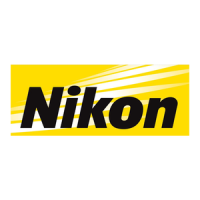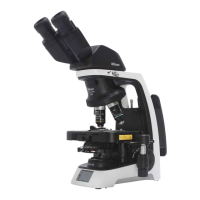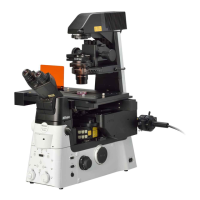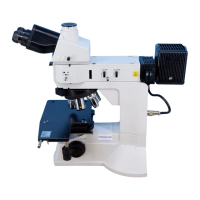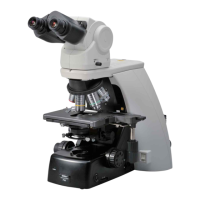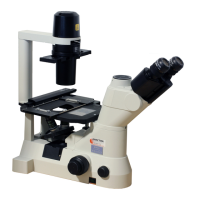Do you have a question about the Nikon Eclipse E400 and is the answer not in the manual?
Explains warning and caution symbols used in the manual for safety.
Details symbols found on the microscope itself and their meanings.
Guidelines for selecting a suitable environment for microscope setup to ensure precision.
Cautions regarding the hot lamp and safe replacement procedures, including cooling times.
Warnings about potential hand injuries from protruding stage parts during operation.
Instructions on handling spills and preventing water damage to the microscope.
Proper techniques for safely carrying and handling the delicate microscope.
How to adjust the condenser aperture for optimal image contrast and definition.
Steps for adjusting diopter for comfortable and clear binocular observation.
Procedures for aligning the condenser for sharp, centered illumination.
How to use the NCB11 filter for natural color tone in images.
Adjusting lamp voltage to influence the color tone of the illumination.
Crucial adjustments for user comfort and image clarity before microscopy.
Detailed guide on adjusting the aperture diaphragm for different objectives.
How to adjust the field diaphragm to limit illumination and improve contrast.
Guidance on choosing and installing eyepiece tubes for photomicrography.
Using the "NO CLICK" switch to minimize vibrations during photomicrography.
Adjusting lamp voltage and using filters for optimal color and brightness.
Adjusting stage rotation for precise specimen positioning during photography.
How to use the coarse focus stopper for quick rough focusing and locking.
Adjusting the resistance of the coarse focus knob for easier manipulation.
Adjusting tension for X and Y axis stage motion control knobs.
Procedures and precautions for using immersion oil with objectives and condensers.
Guidelines for using water-immersion objectives and handling water.
Lists necessary tools and checks input voltage before assembly.
Warnings and cautions to prevent electrical shock and damage during assembly.
Proper procedures for connecting the microscope's power cord.
Guidance on installing separately sold accessories according to their manuals.
How to physically install the condenser onto the microscope.
Procedures for aligning the condenser for optimal illumination.
Steps for mounting the stage onto the substage correctly.
How to screw objectives into the revolving nosepiece.
How to attach the eyelevel riser for adjusting eyepiece height.
Procedures for attaching the eyepiece tube to the riser or arm.
Steps for inserting the left and right eyepieces into the tube.
Guidelines for cleaning various lenses using appropriate cleaning agents.
General advice on maintaining the cleanliness of the microscope body.
Recommendations for storing the microscope to prevent damage.
Importance of regular checks and maintenance for peak performance.
Common problems related to image visibility, focus, and control functions.
| Type | Biological Microscope |
|---|---|
| Optical System | CFI60 Infinity Optical System |
| Nosepiece | Quadruple nosepiece |
| Magnification | 40x to 1000x |
| Power Supply | AC 100-240V, 50/60Hz |
| Lamp Power | 6V 30W |
| Eyepiece | 10x |
| Objective Lenses | 4x, 10x, 40x, 100x |
| Stage | Mechanical stage |
| Focus | Coaxial coarse and fine focusing |
| Condenser | Abbe condenser, N.A. 1.25 |
| Observation Tube | Binocular |
| Stage Dimensions | 134mm |
| Interpupillary Distance Adjustment | 50-75mm |
| Diopter Adjustment | +/- 5 diopters |
| Illumination | Built-in Koehler illumination |
